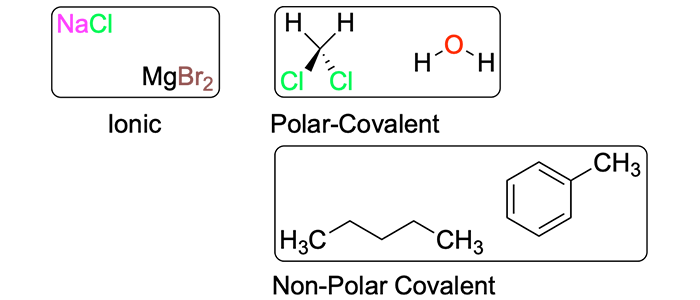Important General Chemistry Concepts

Reading & References
- OpenStax 4.2: Covalent Bonding
- OpenStax 4.5: Formal Charges and Resonance
- OpenStax 4.6: Molecular Structure and Polarity
- OpenStax 5.2: Hybrid Atomic Orbitals
- OpenStax 5.4: Molecular Orbital Theory
- OpenStax 14.3: Relative Strengths of Acids and Bases
Learning Goals
- Covalent Bonding
- “Octet Rule” as a pattern for predicting bonding patterns
- Electronegativity trend on the periodic table
- Apply to classification of bonds as: Non-polar Covalent, Polar Covalent, Ionic Bonds
- Distinguish the difference between a molecular dipole moment and a full separation of charge
- Identify the common bonding patterns for C, N, O, H, and the Halogens
- Molecular Orbitals
- s (sigma) and p (pi) bonds based upon the overlap of atomic/hybrid orbitals
- Hybridization and molecular shape for sp, sp2, sp3 atoms
- Describe the percent composition (%s + %p)
- Bond Angles
- Electronic & Molecular (Observable) Geometry
- By inspection, be able to identify the hybridization of any atom in a molecule
- Identify the type of orbital describing a lone pair on a structure
- Construct an Orbital Diagram (Picture) of a molecule which:
- Clearly shows the s (sigma) and p (pi) bonds and their overlap
- Indicates the hybridization and geometry around all atoms
- Label the types of orbitals containing non-bonding electrons
- Structural Formulae
- Be able to interpret molecular structures using:
- Lewis Structures
- Condensed Structure
- Line-Angle Structure
- Describe some advantages and disadvantages to each representation
- Be able to interpret molecular structures using:
- Formal Charge
- Identify formal charges for any atom in a given molecule
- Resonance
- Explain the difference between a resonance form and a structural isomer
- Identify all potential resonance forms of a molecule
- Criteria for determining the major resonance contributor
- Full Octet (outer shell) for all atoms
- Minimize charges
- Negative charges housed on the most electronegative atom
- Delocalization due to Resonance, impact on structure and reactivity of molecules
- Acids/Bases
- Compare and use 3 different definitions for acids and bases: Arrhenius, Bronsted-Lowry, Lewis
- Acid dissociation Constant (Ka) and pKa
- For a given Acid/Base reaction:
- Identify the conjugate acid-base pairs
- Draw arrows to depict the flow of electron pairs (Curved Arrow Formalism)
- Determine the equilibrium location (products vs starting materials) for a reaction using pKa
- Relative Acidity Strength
- Given a set of acids, determine the relative acidities based upon conjugate base stability